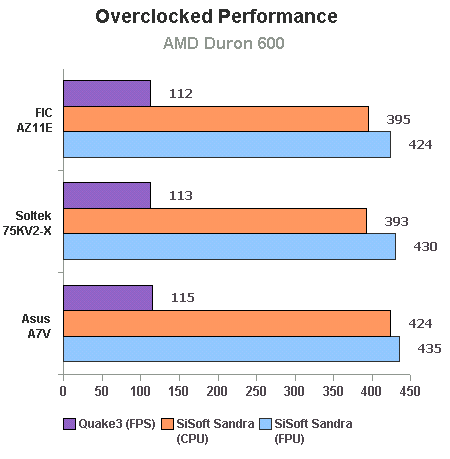|

|
A few short months ago came the introduction of VIA's KT133 chipset. Though the chipset itself has remained pretty much constant (aside from a minor Southbridge revision), host motherboards have been going through good deal of change in a relatively short amount of time. Current generation motherboards now include multiplier adjustments, ATA/100 support and more recently, some form of Voice Diagnosis a feature that is catching on rather quickly.
85% Rating: 
|
|
|
|
Home >
Reviews >
Motherboards >
FIC AZ11E |
|
|
NOVUS II
With the AZ11E, FIC
has included a decent selection of useful software. These new utilities add a
good value addition to the AZ11E as a whole. This NOVUS II includes software
such as BIOS Guardian, Easy Key, Overclock Partner, Clockometer, LogoGenie and
Audio Alert II.
BIOS Guardian acts as sort of a shield against BIOS
attacking virii. Essentially, BIOS Guardian allows the user to enable BIOS
writing when needed and disable it when you don't. Easy Key provides a set of
hot keys / shortcuts to jump to specific areas of the BIOS. Overclock Partner
allows the system to switch back to default BIOS settings in event an overclock
attempt doesn't permit the system to boot. As you might be able to tell, these
are not exactly new and innovative features as FIC might point them out to be.
In fact, we have seen similar options available on ABIT boards quite some time
ago.
LogoGenie, on the other hand, is a feature which not many choose to
implement. LogoGenie allows you to replace the standard POSTing screen with a
640x480x16 bitmap. Though you and I might not find this too useful, OEMs should
have a blast by splashing their logo on bootup.
Clockometer is a feature
which allows you to modify FSB speeds from Windows as opposed to the normal BIOS
entry method.
Audio Alert II is an optional feature that comes as a
daughterboard to plug into the AZ11E. Its something similar to Soltek's VD-Tech
in that a voice message is played upon boot up in case any errors occur. If you
don't like the voices that are included in the chip, software is included for
the user to make custom voice messages and greetings that can be
stored.
Overclocking & Stability
The inclusion of multiplier
adjustments is probably the most noticeable change between the AZ11 and the
AZ11E. Using an unlocked Duron 600, we were able to overclock the chip to a good
950MHz at a 1.75Vcore. This is the maximum we could squeeze with the AZ11E.
Getting it up that high is definitely good, but it certainly isn't the best we
have seen. We were able to overclock the same chip to 1GHz with a Soltek board
in a previous review. Still, the AZ11E is quite a formidable overclocking
solution.

Stability-wise, we are quite
content with this board. For the most part, the AZ11E is crash-free. Only during
our Winstone tests did we find it falter a time or two. Under normal usage, we
don't seem to have any complaints.
Conclusion
After going through
feature-after-feature, benchmark-after-benchmark, were we satisfied that the
AZ11E is a valid solution for the Socket A platform? For the money you for pay
for this board, you certainly get a good bang for the buck. The software bundle
is almost to the point of being exhaustive, it performs well and is a strong
overclocker.
The 686B Southbridge offers ATA/100 which adds to the
longevity of this product to a certain extent. We did find that the AZ11E
doesn't provide much room for oversized heatsinks. We tried to install a
Thermaltake Chrome Orb but the area around the socket was just a bit over
occupied.
Overall, we liked this board quite a bit though we would have
preferred greater control of the board from its BIOS. But don't get me wrong,
the AZ11E has more features than you can think of and then
some...
|
|
|
|
